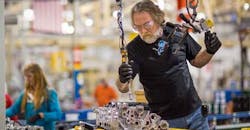Engage Your Employees with New Dimensions in Workforce Management
Despite continued automation and new Industry 4.0 technologies emerging in manufacturing plants today, employees still play and will continue to play a mission-critical role in the success of the industry.This is why it is imperative for manufacturers to do all they can to truly engage their employees – and make sure they are happy and motivated to contribute to the company’s goals.
Employee engagement isn’t just a nice gesture; many companies now see it as an operational imperative, and one that delivers significant business results. For example, research has shown that organizations with a highly engaged workforce experience productivity levels 22% higher than those that don’t – a significant edge in an industry where every advantage counts.
According to Gallup, employees in manufacturing jobs are now the least engaged, compared to other industries, indicating the industry still struggles with how to actually increase employee engagement. While Industry 4.0 technologies – such as artificial intelligence, machine learning, analytics, and mobile solutions – are being implemented in plants all around the world to transform manufacturing production processes, little has been done to transform the employee experience.
Until now. These same technologies are now available in the next generation of workforce management solutions, which can have a major impact on the employee experience, leading to higher levels of engagement and better business outcomes.
New dimensions in technology deliver new results for manufacturers
The following are just a few examples that illustrate how these new advancements in workforce management technology can help manufacturers today.
Work smarter: Empower managers with machine learning and embedded analytics
Leading workforce management solutions now include powerful embedded analytics capable of delivering the context, awareness, and analysis of key decisions – in the moment they must be made. Additionally, machine-learning solutions can detect meaningful patterns within mountains of data to learn from various behaviors and make highly relevant recommendations.
For example, machine learning’s predictive capabilities can provide specific guidance to automate routine workforce management decisions, such as whether (or not) a time-off request should be approved. These recommendations “consider” such variables as if there is enough coverage in the schedule if the employee has the necessary time-off balances, and many other factors. This helps busy managers focus on higher value business priorities such as employee training and development or continuous improvement initiatives.
In the case of embedded analytics, this technology can now provide visibility to real-time key performance indicators (KPIs), which help make managers’ jobs easier by delivering relevant metrics such as workforce productivity, overtime, and other information. KPIs can be tailored to meet the organization’s specific needs, and managers can easily set KPI targets and thresholds to monitor performance with the help of highly visual dashboards and interactive reporting. With proactive insights, managers now have the information they need to coach employees to improve performance and make faster, smarter business decisions.
Work your way: Enhance the employee and manager experience with easy-to-use mobile tools
Additional new innovations in workforce management technology also include the ability for applications to operate entirely on a user’s preferred mobile device.
From employees’ perspectives, this mobility now gives them much more visibility, input, and control over their own work experience, especially in areas such as scheduling. If something comes up unexpectedly – for example, one of their children advances in a baseball tournament – they can use their mobile devices to quickly post their shifts to a shift-trade board. Such capabilities promote and support work/life balance, which can significantly enhance the employee experience and increase overall engagement.
For managers, mobile solutions free them so they don’t have to be trapped behind a desk and can be productive anywhere, anytime. Managers are no longer tethered to the back office. They can now manage in the moment from the plant floor while interacting with their employees where they can have the biggest impact. Because these solutions are device-agnostic, users can easily move from desktop to tablet to phone, with the same experience and without feature loss.
And for all users, the latest in workforce management technology is completely optimized for the mobile experience. Device agnostic workforce management technology is so easy to use that it requires little to no training and enables users to interact with their workforce management system in the same way they would order an Uber ride or post an update on Facebook. One-click actions offer new improvements over traditional workflow and processes such as calling out sick, submitting time-off requests, reviewing timecards, swapping shifts, building schedules, and so much more.
The future of workforce management starts now
To stay a step ahead in today’s highly competitive environment, manufacturers need to do all they can to envision the future of their business and continue to focus on employee engagement in order to drive business results. And as Industry 4.0 technologies continue to be part of manufacturing plants all around the world; these same technologies are now part of innovative, next-generation workforce management solutions.
It adds up to a powerful new advantage. These new dimensions in how global manufacturing workforces are managed help empower managers to make smarter, faster decisions while having the time needed to invest in their most valuable resource – their people. In turn, this helps manufacturers improve the way they consistently engage their workforce and achieve even better business outcomes.
Kylene Zenk is the director of the Manufacturing Practice Group for Kronos Incorporated
